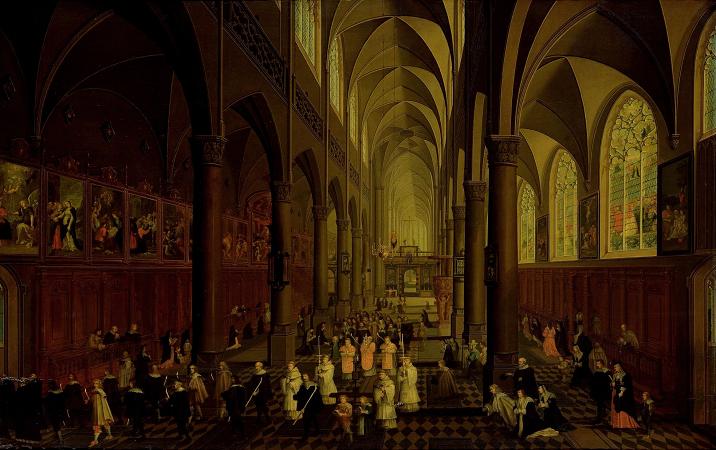Saint Paul's Church, Antwerp. The St. Paul's Church or Sint-Pauluskerk is a Roman Catholic church located at the Veemarkt in Antwerp. Its exterior is mainly Gothic with a Baroque tower while the interior is characterised by its rich Baroque decoration. The St. Paul's Church is located in the old city center of Antwerp, just a few steps from the Scheldt river, in a district where formerly sailors used to live. A small church was built here by the Dominican Order and consecrated in 1276 by Albertus Magnus. The church is named after the patron saint of the Dominicans, St. Paul. As the church had become exposed to flooding as a result of a change in course of the Scheldt river, the Dominican Prior A. van Leent decided to build a new church on a larger and higher-lying piece of land next to the existing church. The construction designs were probably made by Domien de Waghemakere, a co-designer of the Antwerp Cathedral. After his death in 1542 Rombout de Dryvere is known to have continued as the architect and master builder. The church was taken into partial use in 1548 and the following year the old church was demolished. The new church was completed and dedicated in 1571. In the same year, the Our Lady of the Rosary fraternity was founded in the church to celebrate the Battle of Lepanto in which the Spanish fleet defeated the Turks. Work on the new monastery probably also started around this time. When the Calvinists came to power in Antwerp in 1578, the Dominicans were expelled, the church and monastery were cleared and the nave of the church was transformed into a Calvinist oratory. The transepts and chancel were partially demolished and part of the monastery was used as a cannon foundry of the army. When in 1584 Farnese laid siege to Antwerp to reclaim it for the Spanish throne, he had a bridge built over the Scheldt to block supply to the city. The defenders of the city tried to send fire ships to ignite the bridge. They used materials from the transepts and choir of St. Paul's Church as ballast in these ships. After the fall of Antwerp in 1585, the Dominican Fathers returned and began to rebuild and refurbish the church and the monastery. The initial phase of the rebuilding of the monastery was undertaken between 1605 and 1616 and reconstruction was completed in 1662. In 1618 the first stone was laid of a new and enlarged choir and transept. In 1639 the new choir was consecrated by the Bishop of Antwerp. During the following decades, the interior of the church was fitted out with Baroque furniture and decoration. The Antwerp sculptor Pieter Verbrugghen I and his workshop made the oak confessionals between 1658 and 1660. The same artist made the oak organ case in the church in 1654 and together with his son Pieter Verbrugghen II he executed the designs for the high altar in 1670. The high altar was dedicated in 1670 by Mgr. Capello of Antwerp. In 1679 a major fire destroyed part of the vaults of the nave and the upper part of the western facade. The damage was repaired in 1680-81 and at the same time the top of the tower was finished in a Baroque style. In 1692 the Venerable Chapel was completed. The Calvary was constructed against the south side of the nave between 1697 and 1747. In 1796 all Dominicans monasteries in the Southern Netherlands were closed down on the order of the French occupiers. At this time all the old church records, containing information about the Dominican Order, the church and the convent, were lost. The church was sold publicly and bought by Dominican Prior Peltiers. He was thus able to save the rich contents of the church. In 1802 the church, the Calvary and part of the monastery were taken over by the city council. The church was consecrated the following year as a parish church, replacing the old, dilapidated St. Walburga Church, which was demolished in 1817. During the Ten Days' Campaign undertaken by the Dutch in 1830 after the Belgian Revolution, a Dutch garrison bombarded Antwerp. The church was damaged and all the 17th century stained glass windows, made after designs by Abraham van Diepenbeeck, were destroyed. In 1833 the interior of the church was changed: the rood screen dating from 1654, which had been executed by Pieter Verbruggen II and his workshop was dismantled to allow an unobstructed view through the nave to the choir. A new rood screen had previously been built on the western side of the nave. In April 1968 a fire destroyed the entire roof of the church, damaged the vaults and the interior, completely burned down the top of the Baroque tower and reduced three-quarters of the monastery to ruins.
more...





